Brief Summary
Yanmar is introducing a new 530-hp, 6 cylinder, 7.4 L common rail diesel engine that is ideal for boats in the 28’ to 40’ range. Not only will this new, compact, high power-to-weight ratio engine be considered for new-build installations, it is also ideal for repower applications. This smoke-free engine meets Tier 2 emission requirements as well as the coming 2012 regulations. Yanmar is the repower diesel brand of choice for powerboaters because of initial cost, compact size, power-to-weight ratio, performance, and dealers who are eager to spend the time with customers that it takes to map-out a proper, and sometimes complicated, repower installation.
Key Features
- Yanmar has developed a common rail diesel engine that is Tier 2 compliant and already prepared to meet the 2012 Tier 3 compliant guidelines.
- The 6CX530 has been designed to be cleaner, quieter, smoother running and more lightweight for its class.
- Hard cast aluminum covers protect you from accidently breaking fragile or moving parts.
- Yanmar’s 6CX530 has a standard 120 amp, 12v alternator to charge the motor’s 200amp starting battery and the house batteries.
- A high pressure fuel pump and Denzo electric driver unit feed the common rail fuel system on this engine.
- Yanmar’s new 6CX530 is a compact, lightweight diesel with good power to weight ratio.
Specifications
| Type of Engine | |
|---|---|
| Number of Cylinders | 6 |
| Horse Power | 530 |
| Configuration | Inline 6 |
| Weight | 1845.00lbs |
| Fuel Type | Diesel |
| Fuel Delivery | Fuel Injected |
| Shaft Length Options | |
| Shift Throttle Control | |
| Displacement | |
| Steering Control | |
| Recommended Fuel | |
| Alternator Output | 120 amp |
| CARB Rating | |
| Engine Monitoring System |
Captain's Report
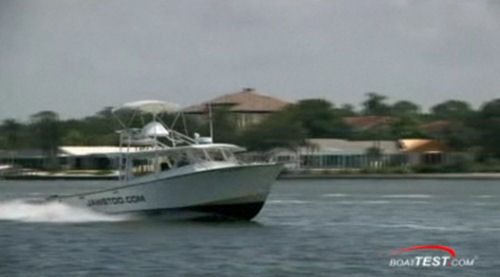 Its owner puts a lot of hours on this Dorado 40, which is humming along nicely with its new 6CX530. The engine is ideal for many boats in the 28’ to 40’ range. It develops 530 hp max, 500 hp continuous.
Its owner puts a lot of hours on this Dorado 40, which is humming along nicely with its new 6CX530. The engine is ideal for many boats in the 28’ to 40’ range. It develops 530 hp max, 500 hp continuous. The 6CX530 is a 6-cylinder, 7.4-liter (452 cid) common-rail diesel. It’s compact, with a high power-to-weight ratio, and meets Tier 2 emission requirements as well as the coming 2012 regulations. At 53” long (without gear) by 35” wide by 37” high and weighing1885 lbs. (the lightest in its class by over 400 lbs), the 6CX530 will fit in most engine rooms without a shoehorn.
It’s electronically governed and freshwater cooled, with a water-shrouded dry turbocharger to squeeze maximum horses out of minimum cubic inches. In short, if you’re looking to repower, the 6CX530 might be just your ticket to ride.
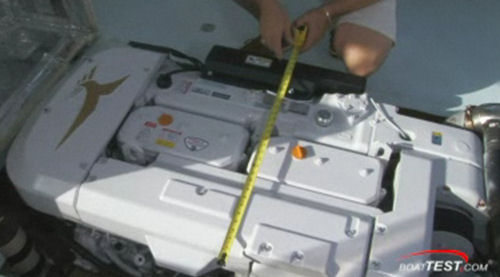 Measure twice, order an engine once. At 35” wide the 6CX530 will fit in most engine rooms – but not all of them. Make sure before placing your order.
Measure twice, order an engine once. At 35” wide the 6CX530 will fit in most engine rooms – but not all of them. Make sure before placing your order. The Challenge or Repowering
Even under the best conditions, repowering can be a challenge, and not only to the pocketbook: Frequently the engine mounts, reduction gear, fuel lines, exhaust, propeller and maybe the shaft have to be changed, too. Sometimes you have no choice – your present engine has gasped its last – but if your present mill is still spinning, it’s a good idea to think before acting. Any project other than an engine-for-engine swap, same make, same model, can harbor all kinds of booby traps.
On the other hand, the folks at Yanmar distributorships have been through the drill before. They know what you can salvage from the old system. Expensive items such as shafts, props and even reduction gears can often be used with your new engine.
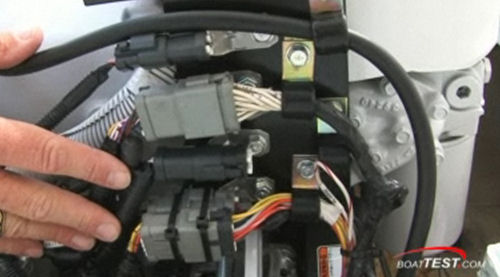 Wiring harnesses are well-secured and positively joined with waterproof snap connectors. The 6CX530 has a standard 120 amp, 12v alternator to charge the motor’s 200-amp starting battery and the house batteries.
Wiring harnesses are well-secured and positively joined with waterproof snap connectors. The 6CX530 has a standard 120 amp, 12v alternator to charge the motor’s 200-amp starting battery and the house batteries. The ideal first step in starting a repower project is to consult with a naval architect, but this is expensive, especially if he or she has to visit the boat, take measurements and so forth. Otherwise, work with a well-established, reputable, full-service yard with lots of repower experience.
Yanmar’s President Speaks
The President of Yanmar of America, Tom Calhoun, is a boating industry veteran who has worked at a number of boat companies, including Bertram Yachts, knows his way around engines and engines rooms, and knows what boaters want, need and expect. He’s also one of just three or four Harvard Business School graduates in the boating industry, but we won’t hold that against him. He shoots it straight.
“This is not for the do-it-yourselfer,” said Calhoun, “It’s important to go to factory-authorized, factory-trained service dealers, particularly with the new electronic diesels. Special training and special tools are required.”
That holds doubly true for gas-to-diesel conversions, popular among boaters tired of mollycoddling tired gasoline engines, and who want diesel’s added efficiency, reliability and safety. (Modern marine gas engines are very reliable if properly maintained, but it’s hard to convince some folks to do that.) While not many folks with gas engines will be looking to move to the powerful 6CX530, today you can find the right model diesel engine for almost any size boat, including sterndrives.
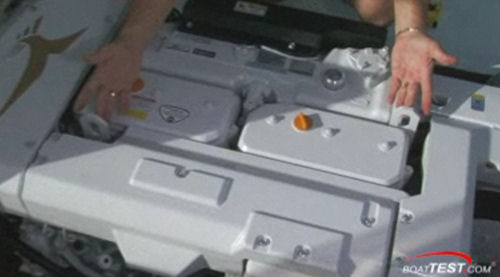 Yanmar fits the 6CX530 with lifting straps to make it easy to handle. Too many engine builders leave it up to the installation team to fabricate these on-site. Yeah, sounds silly to us, too, but it’s true.
Yanmar fits the 6CX530 with lifting straps to make it easy to handle. Too many engine builders leave it up to the installation team to fabricate these on-site. Yeah, sounds silly to us, too, but it’s true. “The newest generation of small, fully electronic diesels with common rail fuel systems, like Yanmar's BY series, offer extremely compact size, excellent power output (up to 260 hp from 3 liters), and the benefits common to most electronic diesel engines,” said Calhoun. These engines offer great fuel economy, almost totally smoke-free operation, built-in diagnostics, fly-by-wire controls and so forth.
Advantages of Diesel over Gas
Changing from gas to diesel is way more complicated than replacing an old diesel with a new one. In most cases, gas engines can be replaced by diesels of less horsepower and still maintain the same cruising speed – diesels can be run continuously at 90% of maximum power vs. 60% or 70% for gas. (The smaller diesels will produce lower top speed, however.) But cutting back too far on horsepower is a common mistake: Some boats take a lot of power to get on plane, much more than to stay on plane. Cutting back too far can result in not enough muscle to push the boat over the hump. That’s why you need an expert by your side.
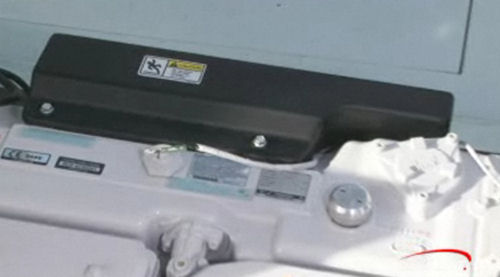 Plastic covers keep the engine looking nice and neat, but don’t step on them. We’d add a warning to that effect, because we’d be the first ones to forget.
Plastic covers keep the engine looking nice and neat, but don’t step on them. We’d add a warning to that effect, because we’d be the first ones to forget. Even today, when diesels are smaller and lighter than ever relative to horsepower, they are still usually bigger than gas engines of similar power, so that can create a space issue. Engine compartments on boats designed for gasoline engines are often very tight. A diesel’s reduction gear might be bigger, too, since it has to handle extra torque; this can cause problems even if the engine itself is the same size.
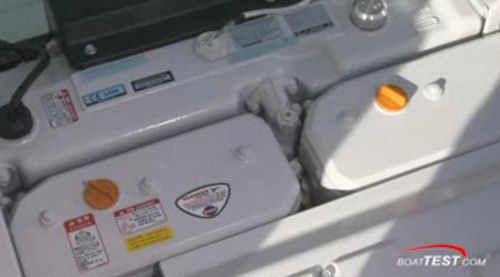 Oil fills are convenient, but use a funnel: White and oil don’t mix. We’d prefer low-profile metal fill caps.
Oil fills are convenient, but use a funnel: White and oil don’t mix. We’d prefer low-profile metal fill caps. More Considerations
The exhaust system is also a consideration. Usually a diesel of similar horsepower to the gas engine being replaced will require somewhat larger exhausts. This can be a big project, because the whole system needs to be re-engineered. Imagine the difference between a V-8 gas engine’s exhaust and one for an inline 6 diesel, for instance. Often this will require fiberglass and/or carpentry work, making it a job for professionals.
 Oil and fuel filters are handy, mounted in a row where they’re easy to reach and service. Common-rail diesels also require a Racor or similar pre-filter to remove coarse gunk before it reaches the engine’s fuel filter. These engines demand nice, clean fuel. A high pressure fuel pump and Denzo electric driver unit feed the common rail fuel system on this engine.
Oil and fuel filters are handy, mounted in a row where they’re easy to reach and service. Common-rail diesels also require a Racor or similar pre-filter to remove coarse gunk before it reaches the engine’s fuel filter. These engines demand nice, clean fuel. A high pressure fuel pump and Denzo electric driver unit feed the common rail fuel system on this engine. Recommendation
While there are some brands and models that make an ideal gas to diesel repower conversion, there are other brands and models where your best route might be to repower with gas. Replacing gas engines with gas engines is less complicated, requires a minimum of re-engineering, and lets you take advantage of today’s EFI systems that improve efficiency and reliability. But once again, don’t do this work yourself! Have a qualified yard make the conversion because a gasoline fuel system in an old boat must be meticulously installed and cared for.
On the other hand, if you own one of those classic boats that with a new engine and a coat of paint could be restored to greatness, then you are a candidate for diesel repowering. Moreover, if you own one of those boats and are interested in range. lowering your operating expense, or peace of mind, then think diesel.
Once past the diesel/gas fork in the road, our advice is to start with your Yanmar distributor. Then, call his competitors and you find out what we’re talking about.